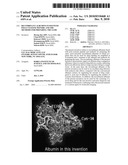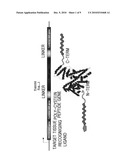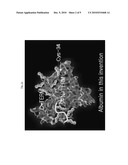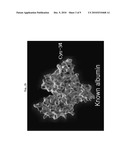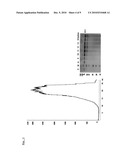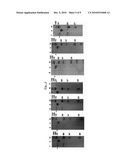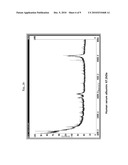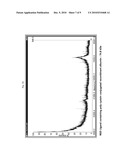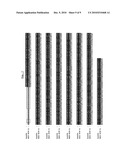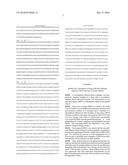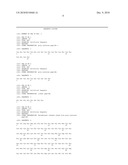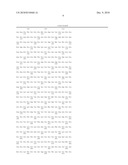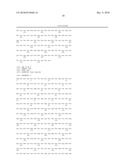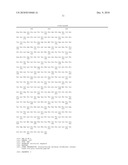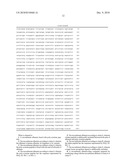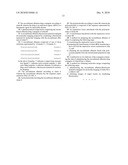Patent application title: RECOMBINANT ALBUMINS FUSED WITH POLY-CYSTEINE PEPTIDE AND THE METHODS FOR PREPARING THE SAME
Inventors:
Hyung Jun Ahn (Seoul, KR)
Ick Chan Kwon (Seoul, KR)
Kuiwon Choi (Seoul, KR)
Kwangmyeng Kim (Seoul, KR)
Inchan Youn (Seoul, KR)
Sehoon Kim (Seoul, KR)
Assignees:
Korea Institute of Science and Technology
IPC8 Class: AC07K1476FI
USPC Class:
424 96
Class name: Drug, bio-affecting and body treating compositions in vivo diagnosis or in vivo testing diagnostic or test agent produces in vivo fluorescence
Publication date: 2010-12-09
Patent application number: 20100310468
Claims:
1. A recombinant albumin fused with poly-cysteine peptide.
2. The recombinant albumin according to claim 1, wherein the albumin is human albumin, its fragment or its variants.
3. The recombinant albumin according to claim 1, wherein the poly-cysteine peptide is fused with one end or both ends of albumin.
4. The recombinant albumin according to claim 1, wherein the poly-cysteine peptide has the sequence represented by SEQ. ID. NO. 1 or NO. 2.
5. The recombinant albumin according to claim 1, wherein a linker peptide is additionally included between both ends of albumin and poly-cysteine peptide.
6. The recombinant albumin according to claim 5, wherein the linker peptide has the sequence represented by SEQ. ID. NO. 3.
7. The recombinant albumin according to claim 1, wherein a target tissue recognition ligand is additionally included.
8. A recombinant albumin-drug conjugate prepared by combining a drug with the recombinant albumin of claim 1 or claim 7.
9. The recombinant albumin-drug conjugate according to claim 8, wherein the drug is an anticancer agent, siRNA or a therapeutic agent for intractable disease.
10. A pharmaceutical composition comprising the recombinant albumin-drug conjugate of claim 8.
11. A recombinant albumin-fluorescent material conjugate for molecular imaging prepared by combining a fluorescent material for molecular imaging with the recombinant albumin of claim 7.
12. A recombinant albumin composed of one of those structures represented by <Formula 1>-<Formula 4>:[T]-[C]-[L]-[A]-[L]-[C]-[D] <Formula 1>[T]-[C]-[L]-[A]-[L]-[C]-[P] <Formula 2>[T]-[C]-[L]-[A]-[L]-[C]-[D]-[P] <Formula 3>[T]-[C]-[L]-[A]-[L]-[C]-[P]-[D] <Formula 4>In the above formulas, T indicates a target tissue recognition ligand, C indicates poly-cysteine peptide, L indicates linker peptide, A indicates albumin, D indicates a drug, and P indicates a fluorescent material for molecular imaging.
13. The recombinant albumin according to claim 1, wherein the recombinant albumin has the sequence represented by SEQ. ID. NO. 4.
14. A polynucleotide encoding the recombinant albumin of claim 1.
15. The polynucleotide according to claim 14, wherein the polynucleotide is composed of the sequence represented by SEQ. ID. NO. 6.
16. An expression vector introduced with the polynucleotide of claim 14.
17. A transformant transfected with the expression vector of claim 16.
18. A method for preparing the recombinant albumin of claim 1 comprising the following steps:1) constructing the expression vector of claim 16;2) preparing the transformant of claim 18 by transfecting a host cell with the expression vector constructed in step 1); and3) obtaining the recombinant albumin fused with poly-cysteine peptide from the transformant prepared in step 2).
19. A method for in vivo delivery of the conjugate containing the step of administering the recombinant albumin-drug conjugate of claim 8 into a subject.
20. A method for obtaining molecular image comprising the following steps:1) administering the recombinant albumin-fluorescent material conjugate for molecular imaging of claim 11 to a subject; and2) obtaining images of target tissues by irradiating fluorescence.
Description:
CROSS-REFERENCES TO RELATED APPLICATION
[0001]This patent application claims the benefit of priority under 35 U.S.C §119 of Korean Patent Application No. 10-2009-0049866 filed on Jun. 5, 2009, the contents of which are incorporated herein by reference.
BACKGROUND OF THE INVENTION
[0002]1. Field of the Invention
[0003]The present invention relates to recombinant albumins fused with poly-cysteine peptide and methods for preparing the same.
[0004]2. Description of the Related Art
[0005]The usability of albumin, as an effective drug in vivo, has been widely known. In particular, in relation to such disease as cancer and rheumatoid arthritis, albumin has been well recognized in its functions as a multi-drug deliverer because of its capability and easiness in improving physical and chemical characteristics such as high accumulation in a target tissue, low invasiveness in a normal tissue, low toxicity, easiness in conjugation with variety of drugs, drug-release in a target tissue, advantageous bio-degradation time, solubility of the fused drug, etc.
[0006]In cancer tissues, albumin is preferably metabolized to produce nitrogen and energy. In angiogenetic blood vessels of cancer tissues, EPR effect (enhanced permeability and retention effect) is observed, that is albumin is accumulated selectively in cancer tissues owing to the increased permeability. Abnormality of lymphatic system in cancer tissues accelerates the accumulation of albumin in cancer tissues. So, drug delivery by albumin is an important target of new drug development, which draws our attention world widely.
[0007]Chemotherapy, one of the conventional methods treating cancer, is limited in clinical application because of biophysicochemical properties of a drug used. That is, if it is a hydrophobic drug insoluble in water, a drug deliverer has to be prepared with an organic solvent such as polyethoxylated castor oil (CrEL) or polysorbate 80. In that case, not only the drug itself but also the drug deliverer can cause toxicity, which can cause hypersensitivity and other serious neuronal disease. Therefore, an additional medical treatment is required to control such toxicity. That is, when a drug deliverer depends on such organic solvent, there might be a problem of dose-limiting because of toxicity of the drug deliverer. Precisely, dose of a drug for in vivo injection can be limited.
[0008]In in vivo drug delivery, in vivo biostability of a drug is also an important factor. Therefore, biostability and half-life can be regulated by the choice of an efficient drug deliverer.
[0009]To reduce the toxicity of a drug deliverer and to improve in vivo biostability of the drug itself, it has been continuously attempted to use albumin protein as a drug deliverer.
[0010]As an attempt to reduce toxicity of a drug deliverer, methotrexate-albumin conjugate, albumin-binding prodrug of doxorubicin (DOXO-EMCH), and paclitaxel albumin-stabilized nanoparticle formulation (brand name "Abraxane®") have been clinically tested and acknowledged as effective albumin based drug deliverers.
[0011]Abraxane has been approved by FDA, USA, in January, 2005, targeting metastatic breast cancer recurrent patients. It demonstrated excellent capability of drug delivery using albumin. American Bioscience Inc. has developed nab-technology, which is the technology to produce nanoparticles based on albumin, resulting in the success of enveloping a lipid-soluble drug in a nanoparticle. To form albumin nano-particles in the size of 100-200 nm, a target drug is added to albumin in aqueous solution and then jet stream is blown through under the high pressure. By this method, the anticancer agent Paclitaxel is sealed in nano particles, resulting in the product named Abraxane® which is clinically treated to metastatic breast cancer patients. Compared with the single-treatment of Paclitaxel, the treatment of Abraxane® demonstrated less side effects such as decrease of leucocytes, mental and body weakness, infection, and muscle ache and the progress of disease was also retarded by the treatment.
[0012]The treatment of Methotrexate known as the agent effective in rheumatoid arthritis is based on the mechanism that albumin is over-accumulated in the region of rheumatoid arthritis and metabolized therein. In an animal model, when Methotrexate/albumin deliverer was administered, treatment effect was improved, compared with when Methotrexate alone was treated.
[0013]As a method to improve biostability of a drug itself, the drug is conjugated with albumin to improve pharmacokinetic profile. For example, there are Albumin Fusion Technology (Human Genome Sciences), Drug Affinity Complex (DAM®, ConjuChem. Inc.), Performed Conjugated-Drug Affinity complex technology platform (PC-DAM®, ConjuChem. Inc.) and the method provided by Novo Nordisk to conjugate a fatty acid derivative physically to albumin circulating in human body.
[0014]Albumin fusion technology provided by Human Genome Sciences is that albumin is conjugated with cytokine protein such as interferon or interleukin by using genetic recombination technique. In this case, protein pegylation like effect is observed along with increase of in vivo half-life, decrease of degradation by protease, and decrease of immune response.
[0015]ConjuChem. Inc. has the technique that is able to conjugate a drug with the 34th cysteine free from disulfide bond in albumin by using a reaction group such as N-hydroxysuccinimide ester, isocyanate, maleimide or salicylate group. The company has been conjugated various peptide drugs with albumin by the said method. As an example, CJC-1134-PC, an exendin-4 albumin complex, has been developed as a therapeutic agent for type II diabetes.
[0016]Concerning the said drug delivery system, methods of drug conjugation with albumin are largely divided into two categories; which are the method using the 34th cysteine residue and the method using lysine residues on the surface of albumin.
[0017]In all the commercial albumins, the 34th cysteine residue of albumin is blocked by sulfhydryl compound such as cysteine, homocysteine and glutathione. So, only 20-60% of the 34th residue can be conjugated with a drug. Therefore, for the effective drug conjugation, it is important to free the 34th cysteine from blocking in commercial albumin.
[0018]A method to produce a prodrug has been attempted by targeting the 34th cysteine residue of albumin circulating in vivo. (4-maleimidophenylacetyl) hydrazone derivative and (6-maleimidophenylacetyl) hydrazone derivative of doxorubicin (DOXO-EMCH) are conjugated with the 34th cysteine residue of albumin circulating in vivo within just a few minutes. In that case, the albumin conjugate DOXO-EMCH demonstrates the maximum tolerated dose 4.5 times as high as that of doxorubicin itself that is the albumin conjugate is much effective in treatment than doxorubicin single treatment.
[0019]However, even in the case that a drug is conjugated with albumin circulating in vivo, drug binding efficiency is still not high enough because about 70% of those circulating albumin contain free 34th cysteine residue, which is in the form of mercaptalbumin opened for drug conjugation.
[0020]Methotrexate-albumin conjugate (MTX-HSA) evaluated until clinical test stage I/II is the example of the second method using lysine residues on the surface of albumin for drug conjugation. This conjugate is produced by direct binding of methotrexate with lysine residue of albumin. However, this methotrexate-albumin conjugate has a problem in identification of the conjugate chemically because of irregularity of numbers of drugs being able to be combined with albumin. Clinical evaluation of the methotrexate-albumin conjugate, a kind of prodrug, is postponed because of its uncertainty in cleavage rate and cleavage product.
[0021]According to the method using lysine residue on the surface of albumin, the number of drugs that are conjugated with each albumin is not consistent, so that the albumin-drug conjugate cannot be chemically identified and at the same time the number of drugs conjugated thereto cannot be controlled.
[0022]Therefore, to overcome the said disadvantages of the conventional albumin-drug conjugation methods, more effective or improved methods for albumin-drug conjugation, for increasing the number of drugs conjugated to each albumin and for regulating the number of drugs conjugated to each albumin are required.
[0023]The present inventors have studied to overcome side effects of the conventional drug delivery system using albumin. As a result, the inventors developed a recombinant albumin by combining albumin with poly-cysteine peptide harboring multi-drug binding sites based on genetic recombination technique. The developed recombinant albumin has the increased number of cysteines that can be useful for drug binding at N-terminal and C-terminal along with the 34th residue, so that it not only improves albumin-drug conjugation efficiency for more effective delivery of a large amount of drugs to a target tissue but also facilitates regulation of the number of fused cysteines to control the number of drugs conjugated to each albumin, indicating that this novel recombinant albumin can be used as an excellent drug deliverer with less side effects than the conventional albumin deliverers. Further, the present inventors completed this invention by confirming that the recombinant albumin developed by the inventors can be effectively used for the non-invasive real-time diagnosis and treatment of disease by combining with a fluorescent material or a contrast agent for molecular imaging.
SUMMARY OF THE INVENTION
[0024]It is an object of the present invention to provide a recombinant albumin that can deliver a large amount of drugs effectively to a target tissue and facilitate the regulation of the number of drugs conjugated with each unit albumin, methods for non-invasive diagnosis for real-time molecular imaging and treatment of disease, and a composition for the diagnosis.
[0025]To achieve the above object, the present invention provides a recombinant albumin fused with poly-cysteine peptide.
[0026]The present invention also provides a recombinant albumin-drug conjugate produced by combining a drug with the said recombinant albumin.
[0027]The present invention further provides a pharmaceutical composition comprising the said recombinant albumin-drug conjugate.
[0028]The present invention also provides a recombinant albumin-fluorescent material conjugate for molecular imaging produced by combining a fluorescent material for molecular imaging with the said recombinant albumin.
[0029]The present invention also provides a composition for disease diagnosis comprising the said recombinant albumin-fluorescent material for molecular imaging. The present invention provides a polynucleotide encoding the said recombinant albumin, an expression vector introduced with the said polynucleotide and a transformant transfected with the said expression vector.
[0030]The present invention also provides a method for preparing the said recombinant albumin comprising the following steps:
[0031]1) constructing the said expression vector;
[0032]2) preparing the said transformant by transfecting a host cell with the expression vector constructed in step 1); and
[0033]3) obtaining the recombinant albumin fused with poly-cysteine peptide from the transformant prepared in step 2).
[0034]The present invention also provides a method for preparing a recombinant albumin-drug conjugate containing the additional step of obtaining a recombinant albumin-drug conjugate by combining a drug with the recombinant albumin obtained in step 3) (step 4).
[0035]The present invention also provides a method for preparing a recombinant albumin-fluorescent material conjugate for molecular imaging comprising the additional step of obtaining a recombinant albumin-fluorescent material conjugate for molecular imaging by combining a fluorescent material for molecular imaging with the recombinant albumin prepared in step 3) (step 4).
[0036]The present invention also provides a method for the treatment of disease containing the step of administering the said recombinant albumin-drug conjugate to a subject.
[0037]The present invention also provides a method for diagnosis of disease comprising the following steps:
[0038]1) administering the recombinant albumin-fluorescent material conjugate for molecular imaging to a subject; and
[0039]2) obtaining images of disease tissues by irradiating fluorescence.
ADVANTAGEOUS EFFECT
[0040]According to the present invention, the recombinant albumin has the increased number of cysteins that can be useful for drug binding at N-terminal and C-terminal along with the 34th residue, so that it not only improves albumin-drug conjugation efficiency for more effective delivery of a large amount of drugs to a target tissue but also facilitates regulation of the number of fused cysteines to control the number of drugs conjugated to each albumin, indicating that this novel recombinant albumin can be used as an excellent drug deliverer with less side effects than the conventional albumin deliverers. In addition, the recombinant albumin of the present invention can be used for the screening of a novel drug and for the non-invasive real-time diagnosis and treatment of disease by combining with a fluorescent material or a contrast agent for molecular imaging.
BRIEF DESCRIPTION OF THE DRAWINGS
[0041]The application of the preferred embodiments of the present invention is best understood with reference to the accompanying drawings, wherein:
[0042]FIG. 1 is a schematic diagram illustrating RGD(Arginine-Glycine-Aspartic acid) peptide gene, poly-cysteine peptide gene, linker peptide gene, recombinant albumin gene and a recombinant albumin fused with poly-cysteine peptide expressed as one amino acid chain therefrom, based on genetic recombination technique.
[0043]FIG. 2a is a diagram illustrating tertiary structure of the recombinant albumin fused with poly-cysteine peptide of the present invention, and FIG. 2b is a diagram illustrating tertiary structure of human serum albumin using only the 34th cysteine residue for the conjugation with a drug (N: N-terminal, C: C-terminal, blue surface model: tertiary structure of albumin indicated as surface model, green circle: possible drug for conjugation, yellow and orange spirals: poly-cysteine residues).
[0044]FIG. 3 is a diagram illustrating molecular weight of the recombinant albumin fused with poly-cysteine peptide of the present invention, confirmed by denatured SDS-PAGE and MALD-TOF (M: protein marker, m: human serum albumin, before: sample before injection, 8-14: eluted fractions).
[0045]FIG. 4 is a set of photographs illustrating the fusion of poly-cysteine peptide with either one or both ends of albumin (N-terminal and C-terminal), resulting in different types of recombinant albumins expressed in Pichia pastoris.
[0046](1: recombinant albumin fused with poly-cysteine peptide represented by SEQ. ID. NO. 1 at C-terminal;
[0047]2; recombinant' albumin fused with poly-cysteine peptide represented by SEQ. ID. NO. 1 at N-terminal;
[0048]3: recombinant albumin fused with RGD at N-terminal and fused with poly-cysteine peptide represented by SEQ. ID. NO. 1 at C-terminal;
[0049]4: recombinant albumin fused with both RGD and poly-cysteine peptide represented by SEQ. ID. NO.1 at N-terminal;
[0050]5: recombinant albumin fused with poly-cysteine peptide represented by SEQ. ID. NO.1 respectively at N-terminal and C-terminal;
[0051]6: recombinant albumin fused with both RGD and poly-cysteine peptide represented by SEQ. ID. NO.1 at N-terminal and fused with poly-cysteine peptide represented by SEQ. ID. NO.1 at C-terminal;
[0052]7: recombinant albumin fused with poly-cysteine peptide represented by SEQ. ID. NO. 2 at C-terminal;
[0053]c: human serum albumin; and,
[0054]m: protein marker)
[0055]FIG. 5a is a graph illustrating the result of mass analysis of human serum albumin using MALDI-TOF, and FIG. 5b is a graph illustrating the result of mass analysis of the recombinant albumin fused with poly-cysteine peptide containing RGD ligand using MALDI-TOF.
[0056]FIG. 6 is a set of graphs illustrating secondary structure and protein folding of human serum albumin and the recombinant albumin fused with poly-cysteine peptide comprising RGF ligand measured by CD (Circular Dichroism).
[0057]FIG. 7 is a diagram illustrating the result of DNA sequencing of human serum albumin and the recombinant albumin fused with poly-cysteine peptide comprising RGF ligand (hsAlb: human serum albumin, RGD-N10-hsA: recombinant albumin fused with poly-cysteine peptide containing RGD ligand, red rim: RGD ligand, blue rim: poly-cysteine peptide motif).
DESCRIPTION OF THE PREFERRED EMBODIMENTS
[0058]Hereinafter, the present invention is described in detail.
[0059]The present invention provides a recombinant albumin fused with poly-cysteine peptide.
[0060]The said albumin is preferably human albumin, its fragments or its variants, but not always limited thereto.
[0061]Albumin is endogenous and it has excellent biocompatibility, biostability, and high blood distribution, so that it can be continuously accumulated in cancer tissues for long enough.
[0062]The said poly-cysteine peptide is preferably fused with either one or both ends of albumin, but not always limited thereto.
[0063]The poly-cysteine peptide preferably contains 1-100 cysteine residues, but not always limited thereto.
[0064]The poly-cysteine peptide contains more than 80% of cysteine residues, preferably more than 60% of cysteine residues, more preferably more than 40% of cysteine residues, and most preferably more than 20% of cysteine residues in its peptide sequence, but not always limited thereto.
[0065]The sequence of the poly-cysteine peptide is not limited to a specific sequence, and the ratio of cysteine to peptide is not limited either. Preferably, the poly-cysteine peptide has the sequence represented by SEQ. ID. NO. 1 or SEQ. ID. NO. 2, but not always limited thereto.
TABLE-US-00001 SEQ. ID. NO. 1: [ CGCGCGCGCGCGCGCGCGCG ] SEQ. ID. NO. [ CSCSCSCSCS ]
[0066]Thiol group of cysteine in the poly-cysteine peptide is easily reacted with maleimide reaction group in a drug or a fluorescent material, resulting in stable carbon-sulfur bond.
[0067]The recombinant albumin of the present invention preferably contains an additional linker peptide, but not always limited thereto.
[0068]The linker peptide is preferably inserted between both ends of albumin and poly-cysteine peptide, but not always limited thereto. The linker peptide is preferably composed of 1-100 amino acids, but not always limited thereto.
[0069]The sequence of the linker peptide is not limited to a specific sequence, but simple structured amino acids with short amino acid side chain or without amino acid side chain is preferred. The sequence is more preferably composed of glycine, serine, and alanine, but not always limited thereto. The sequence is also preferably the one represented by SEQ. ID. NO. 3, but not always limited thereto.
TABLE-US-00002 SEQ. ID. NO. 3: [ GSGAGSGA ]
[0070]The linker peptide acts as a linker connecting poly-cysteine peptide to albumin during genetic recombination process.
[0071]The recombinant albumin of the present invention preferably contains a target tissue recognition ligand, but not always limited thereto.
[0072]The target tissue recognition ligand is conjugated to one or both ends of poly-cysteine peptide by protein chain linking or covalent, bonding, or conjugated to a residue of poly-cysteine peptide based on genetic recombination technique, but not always limited thereto.
[0073]The target tissue recognition ligand is selectively binding to a receptor over-expressed in a specific target tissue such as cancer cells. Thus, when it is added to the recombinant albumin of the present invention, it endows the recombinant albumin specific target (such as cancer cells) oriented function. The target recognition ligand of the present invention includes any material that can be selectively recognized by a target tissue.
[0074]The target tissue recognition ligand is preferably selected from the group consisting of peptides containing RGD (Arginine-Glycine-Aspartic acid), aptamer, and folate, but not always limited thereto.
[0075]The peptide containing RGC used as a target recognition ligand is the one that has one or more repetitive motifs binding to the receptor of vascular endothelial growth factor (VEGF), and is capable of endowing target-orientation toward cancer cells.
[0076]The present invention also provides a recombinant albumin-drug conjugate produced by combining a drug with the said recombinant albumin and a pharmaceutical composition comprising the recombinant albumin-drug conjugate.
[0077]The drug herein includes every drug that can be successfully delivered to a target, tissue by being conjugated with thiol group of poly-cysteine peptide. Preferably, it is an anticancer agent, siRNA or a therapeutic agent for intractable disease, and more preferably it is selected from the group consisting of Docetaxel, cis-platin, camptothecin, paclitaxel, Tamoxifen, Anasterozole, Gleevec, 5-FU, Floxuridine, Leuprolide, Flutamide, Zoledronate, Doxorubicin, Vincristine, Gemcitabine, Streptozocin, Carboplatin, Topotecan, Belotecan, Irinotecan, Vinorelbine, hydroxyurea, Valrubicin, retinoic acid, Methotrexate, Meclorethamine, Chlorambucil, Busulfan, Doxifluridine, Vinblastin, Mitomycin, Prednisone, Testosterone, Mitoxantron, aspirin, salicylates, ibuprofen, naproxen, fenoprofen, indomethacin, phenyltazone, cyclophosphamide, mechlorethamine, dexamethasone, prednisolone, celecoxib, valdecoxib, nimesulide, cortisone and corticosteroid, but not always limited thereto.
[0078]The method of combining the drug with thiol group of poly-cysteine peptide is exemplified by the conjugation using maleimide reaction group, the conjugation using idoacetyl reaction group, or the conjugation using pyridyl disulfide reaction group, but not always limited thereto.
[0079]When the recombinant albumin-drug conjugate of the present invention is used, biostability can be regulated based on the interaction between albumin and the drug fused with poly-cysteine peptide by regulating the length of a linker peptide connecting poly-cysteine peptide and albumin.
[0080]The present invention also provides a recombinant albumin-fluorescent material conjugate for molecular imaging produced by combining a fluorescent material for molecular imaging with the said recombinant albumin and a composition for disease diagnosis comprising the said recombinant albumin-fluorescent material for molecular imaging.
[0081]The fluorescent material for molecular imaging herein is conjugated to one or both ends of poly-cysteine peptide by protein chain linking or covalent bonding, or conjugated to a residue of poly-cysteine peptide based on genetic recombination technique, but not always limited thereto.
[0082]The fluorescent material for molecular imaging herein includes every material that can irradiate fluorescence, and more preferably the one that can irradiate red or near-infrared fluorescence, and most preferably the one that has high quantum yield, but not always limited thereto.
[0083]The fluorescent material for molecular imaging is preferably a fluorescent material, a fluorescent protein, or any other material for imaging that has the bond of thiol group of poly-cysteine peptide and maleimide reaction group, but not always limited thereto.
[0084]The fluorescent material having the bond of thiol group and maleimide reaction group is exemplified by fluorescein, BODYPY, Tetramethylrhodamine, Alexa, Cyanine, allopicocyanine and their derivatives, but not always limited thereto. Among these fluorescent materials, cyanine and Alexa release and absorb near-infrared ray, indicating that intervention or absorption into cells, blood and biotissues becomes minimized, which are preferred.
[0085]The fluorescent protein herein is preferably exemplified by Dronpa protein, EGFP, red fluorescent protein (DsRFP), Cy5.5 and other fluorescent proteins, but not always limited thereto.
[0086]Other materials for imaging that can be included in this invention are preferably iron oxide, radio-isotope, etc, but not always limited thereto. And these materials can be applied to imaging systems such as MR and PET.
[0087]The recombinant albumin of the present invention can effectively deliver a drug or a fluorescent material for molecular imaging to a target cell or tissue. Therefore, it is suitable for multi-purpose utilization including drug delivery system, cellular imaging, specific tissue imaging, etc, and can be applicable in vivo and in vitro as well.
[0088]The recombinant albumin of the present invention is preferably represented by one of the following <Formula 1>-<Formula 4>, but not always limited thereto:
[T]-[C]-[L]-[A]-[L]-[C]-[D] <Formula 1>
[T]-[C]-[L]-[A]-[L]-[C]-[P] <Formula 2>
[T]-[C]-[L]-[A]-[L]-[C]-[D]-[P] <Formula 3>
[T]-[C]-[L]-[A]-[L]-[C]-[P]-[D] <Formula 4>
[0089]In the above formulas, T indicates a target tissue recognition ligand, C indicates poly-cysteine peptide, L indicates a linker peptide, A indicates albumin, D indicates a drug, and P indicates a fluorescent material for molecular imaging.
[0090]As shown in FIG. 1, the recombinant albumin of the present invention can be constructed by using RGD peptide gene, poly-cysteine peptide gene, linker peptide gene, and recombinant albumin gene, that is, from those genes a recombinant albumin expressed as one amino acid chain can be obtained.
[0091]As shown in FIG. 2a and FIG. 2b, the obtained recombinant albumin contains multiple cysteines which are the locations for drug binding, so that the albumin-drug conjugation efficiency can be increased and accordingly a large amount of drug can be effectively delivered to target tissues. While preparing the recombinant gene, the number of cysteines can be regulated, by which the number of drugs that are supposed to be conjugated to each unit albumin can also be regulated.
[0092]The obtained recombinant albumin is separated and purified by ion exchange chromatography and size-exclusion gel filtration chromatography. Molecular weight of the recombinant albumin is confirmed by denatured SDS-PAGE and mass spectrometry (see FIG. 3).
[0093]As shown in FIG. 4, poly-cysteine peptide is fused alone to either N-terminal or C-terminal of albumin or to both ends of it, resulting in different kinds of recombinant albumins, which can be found in Pichia pastoris.
[0094]From the mass spectrometry, it was confirmed that human serum albumin and the recombinant albumin fused with poly-cysteine peptide had 67.2 kDa and 74.8 kDa, respectively, suggesting that there is 7.6 kDa difference in molecular weight between the two (see FIGS. 5a and 5b). The recombinant albumin fused with poly-cysteine peptide showed the same protein folding as human serum albumin (see FIG. 6).
[0095]Therefore, the recombinant albumin of the present invention dose not affect the 3 dimensional structure and functions of albumin and at the same time maintains its unique physical and chemical properties. This suggests that the recombinant albumin keeps the functions for effective drug delivery in addition to the advantageous characteristics such as high accumulation in target tissues such as cancer and rheumatoid arthritis tissues, low invasiveness in normal tissues, low toxicity, capability of binding with various drugs and drug release in target tissues, preferable biodegradation time for excellent stability, excellent biocompatibility, and preferable solubility of fused drug, etc. The recombinant albumin of the present invention maintains the excellent functions of albumin, particularly functions for drug delivery, and at the same time reduced side effects which are common in the conventional albumin, so that it can be used as an excellent drug deliverer.
[0096]DNA sequencing with the recombinant albumin expressed in Pichia pastoris was performed. As a result, it was confirmed to have the same albumin region and RGD ligand peptide and poly-cysteine peptide motif were expressed as expected (see FIG. 7). Therefore, it was confirmed that the sequence and the length of poly-cysteine peptide to be fused with albumin by genetic recombination could be regulated.
[0097]The recombinant albumin of the present invention can be fused with siRNA to produce a disulfide bond conjugate of siRNA-recombinant albumin fused with poly-cysteine peptide.
[0098]As explained hereinbefore, the recombinant albumin fused with poly-cysteine peptide of the present invention facilitates modification and control of poly-cysteine peptide, a linker peptide, a drug, a fluorescent material for molecular imaging, and a target recognition ligand, suggesting that it is easy to control specific drug/albumin ratio, specific types of drugs, fluorescence of specific wave length band, and target specific recognition ligand. Therefore, carriers based on different albumins can be designed with the recombinant albumin of the invention.
[0099]The present invention provides a polynucleotide encoding the said recombinant albumin, an expression vector introduced with the said polynucleotide and a transformant transfected with the said expression vector.
[0100]The present invention also provides a method for preparing the said recombinant albumin comprising the following steps:
[0101]1) constructing the said expression vector;
[0102]2) preparing the said transformant by transfecting a host cell with the expression vector constructed in step 1); and
[0103]3) obtaining the recombinant albumin fused with poly-cysteine peptide from the transformant prepared in step 2).
[0104]In the above method, the expression vector step 1) has preferably the structure that poly-cysteine peptide gene is fused with one or both ends of albumin gene, but not always limited thereto.
[0105]In the above method, the host cell of step 2) is preferably Pichia pastoris, but not always limited thereto.
[0106]In the above method, the additional step for separation and purification or identification of the recombinant albumin prepared in step 3) can be included.
[0107]The present invention also provides a method for preparing a recombinant albumin-drug conjugate containing the additional step (step 4) of obtaining a recombinant albumin-drug conjugate by combining a drug. with the recombinant albumin obtained in step 3).
[0108]The present invention also provides a method for preparing a recombinant albumin-fluorescent material conjugate for molecular imaging comprising the additional step (step 4) of obtaining a recombinant albumin-fluorescent material conjugate for molecular imaging by combining a fluorescent material for molecular imaging with the recombinant albumin prepared in step 3).
[0109]The present invention also provides a method for the treatment of disease containing the step of administering the said recombinant albumin-drug conjugate to a subject.
[0110]The recombinant albumin-drug conjugate of the present invention can be used for the diagnosis and treatment of various diseases including cancer, osteoarthritis, rheumatoid arthritis, dementia, autoimmune disease, and stroke.
[0111]The cancer herein is preferably squamous cell carcinoma, uterine cancer, cervical cancer, prostate cancer, head and neck cancer, pancreatic cancer, brain tumor, breast cancer, liver cancer, skin cancer, esophageal cancer, testicular cancer, kidney cancer, colon cancer, rectal cancer, stomach cancer, bladder cancer, ovarian cancer, cholangioma, or gallbladder cancer, but not always limited thereto.
[0112]The present invention also provides a method for the diagnosis of disease comprising the following steps:
[0113]1) administering the recombinant albumin-fluorescent material conjugate for molecular imaging to a subject; and
[0114]2) obtaining images of disease tissues by irradiating fluorescence.
[0115]The recombinant albumin of the present invention can be used to inhibit overexpression of a target gene by delivering siRNA to a target gene in various types of cancer cells and used for the screening of a novel drug having the said mechanism.
[0116]Practical and presently preferred embodiments of the present invention are illustrative as shown in the following Examples, Experimental Examples and Manufacturing Examples.
[0117]However, it will be appreciated that those skilled in the art, on consideration of this disclosure, may make modifications and improvements within the spirit and scope of the present invention.
EXAMPLE 1
Construction of Expression Vector for Recombinant Albumin Fused with Poly-Cysteine Peptide
[0118]Genetic recombination technique was used to insert poly-cysteine peptide and a linker peptide into albumin. The expression vector used herein was pUIC9 which is the expression vector of Pichia pastoris. The sequence inducing expressions of poly-cysteine peptide and a linker peptide was inserted by using a restriction enzyme.
[0119]The inserted poly-cysteine peptide amino acid sequence was the one represented by SEQ. ID. NO. 1 or NO. 2. The poly-cysteine peptide was fused with either N-terminal or C-terminal of albumin or both ends simultaneously.
TABLE-US-00003 SEQ. ID. NO. 1: [ CGCGCGCGCGCGCGCGCGCG ] SEQ. ID. NO. 2: [ CSCSCSCSCS ]
[0120]The linker peptide was the peptide represented by SEQ. ID. NO. 3, and glycine, serine, and alanine were mainly used.
TABLE-US-00004 SEQ. ID. NO. 3: [ GSGAGSGA ]
[0121]To endow target-orientation toward cancer cells, RGD peptide that is conjugated with a receptor over-expressed in cancer cells was fused in front of the poly-cysteine peptide sequence.
[0122]The sequence encoding poly-cysteine peptide, the sequence encoding a linker peptide and RGD peptide gene in pUIC9 expression vector are illustrated in FIG. 1.
EXAMPLE 2
Mass-Expression, Separation and Purification of Recombinant Albumin Fused with Poly-Cysteine
[0123]Following experiment was performed to insert a recombinant albumin fused with poly-cysteine comprising RGD into HIS4 region.
[0124]The expression vector was digested with SalI, followed by purification with column. Competent cells (40 μl) were transformed with 100 ng of the obtained DNA by electrophoration. HIS+phenotype producing histidine was selected from HIS(-) media.
[0125]Among the 50 transformants obtained above, Mut+phenotypes well growing in both MD and MM were selected by replica method using a control strain (GS115 Albumin: HIS+Muts). Genomic DNA was separated from 8 HIS+Mut+ strains, followed by PCR to confirm the insertion. Strains confirmed by all of the above three methods were selected and used for expression test.
[0126]Seed culture (300, 180-200rpm, 12 hours) was performed in BMGY culture flask (BMGY 20 ml/250 ml baffled flask). The cells were harvested and inoculated in BMMY culture flask (BMMY 50 ml/250 ml baffled flask), followed by small scale expression test.
[0127]Methanol induction was performed at the concentration of 0.5% every 12 hours. While culturing 0-96 hours, optimum culture conditions were searched. The conditions are as follows.
[0128][HIS(-) medium: YBB 6.7 g, HIS DO supplement 0.77 g, glucose 20 g, agar 15 g]
[0129][MM medium: YNB 13.4 g, biotin 4×10-5%, methanol 0.5%, agar 15 g]
[0130][MD medium: YNB 13.4 g, biotin 4×10-5%, glucose 20 g, agar 15 g]
[0131][BMGY medium: 0.1 M potassium phosphate buffer (pH 6.0), YNB 13.4 g, yeast extract 10 g, bactopeptone 20 g, Glycerol 10 g, biotin 4×10-5%]
[0132][BMMY medium: 0.1M potassium phosphate buffer (pH 6.0), YNB 13.4 g, yeast extract 10 g, bactopeptone 20 g, methanol 0.5%, biotin 4×10-5%]
[0133]Media were collected and concentrated. Proteins were separated and purified by ion exchange chromatography and size-exclusion gel filtration chromatography. Molecular weight of the purified protein was confirmed by denatured SDS-PAGE and MALD-TOF. The results are shown in FIG. 3-FIG. 5.
[0134]As shown in FIG. 3, molecular weight of the recombinant albumin fused with poly-cysteine peptide was confirmed by denatured SDS-PAGE and MALD-TOF (M: protein marker, m: human serum albumin, before: sample before injection, 8-14: eluted fractions).
[0135]As shown in FIG. 4, different types of recombinant albumins, fused with poly-cysteine peptide either at N-terminal or C-terminal of albumin or both ends of albumin, were expressed in Pichia pastoris.
[0136]To investigate the molecular weights of the conventional human serum albumin and the recombinant albumin fused with poly-cysteine peptide comprising RGD ligand, mass analysis was performed by using MALDI-TOF (FIG. 5a and FIG. 5b). As shown in FIG. 5a and FIG. 5b, human serum albumin had 67.2 kDa and the recombinant albumin fused with poly-cysteine peptide of the present invention had 74.8 kDa, indicating there was 7.6 kDa difference in molecular weight between the two.
[0137]To investigate whether secondary structure and protein folding were changed in the recombinant albumin fused with poly-cysteine comprising RGD ligand, protein folding was measured by Circular Dichroism (CD) (FIG. 6). As shown in FIG. 6, the same protein folding was observed in the recombinant albumin fused with poly-cysteine and in human serum albumin.
[0138]DNA sequencing was performed with the recombinant albumin expressed in Pichia pastoris (FIG. 7). As a result, albumin region of the recombinant albumin was same as that of the conventional albumin, and RGD ligand peptide motif and poly-cysteine peptide motif were expressed as designed.
[0139]The following sequence represented by SEQ. ID. NO. 4 is the amino acid sequence of the recombinant sequence represented by SEQ. ID. NO. 5 is the amino acid sequence of human serum albumin, and the sequence represented by SEQ. ID. NO. 6 is the poly-nucleotide sequence encoding the recombinant albumin.
TABLE-US-00005 SEQ. ID. NO. 4: YVRGDGASAGSGEFCGCGCGCGCGCGCGCGCGCDAHKSEVAHRFKDLGE ENFKALVLIAFAQYLQQCPFEDHVKLVNEVTEFAKTCVADESAENCDKS LHTLFGDKLCTVATLRETYGEMADCCAKQEPERNECFLQHKDDNPNLPR LVRPEVDVMCTAFHDNEETFLKKYLYEIARRHPYFYAPELLFFAKRYKA AFTECCQAADKAACLLPKLDELRDEGKASSAKQRLKCASLQKFGERAFK AWAVARLSQRFPKAEFAEVSKLVTDLTKVHTECCHGDLLECADDRADLA KYICENQDSISSKLKECCEKPLLEKSHCIAEVENDEMPADLPSLAADFV ESKDVCKNYAEAKDVFLGMFLYEYARRHPDYSVVLLLRLAKTYETTLEK CAAADPHECYAKVFDEFKPLVEEPQNLIKQNCELFEQLGEYKFQNALLV RYTKKVPQVSTPTLVEVSRNLGKVGSKCCKHPEAKRMPCAEDYLSVVLN QLCVLHEKTPVSDRVTKCCTESLVNRRPCFSALEVDETYVPKEFNAETF TFHADICTLSEKERQIKKQTALVELVKHKPKATKEQLKAVMDDFAAFVE KCCKADDKETCFAEEGKKLVAASQAALGL SEQ. ID. NO. 5: DAHKSEVAHRFKDLGEENFKALVLIAFAQYLQQCPFEDHVKLVNEVTEF AKTCVADESAENCDKSLHTLFGDKLCTVATLRETYGEMADCCAKQEPER NECFLQHKDDNPNLPRLVRPEVDVMCTAFHDNEETFLKKYLYEIARRHP YFYAPELLFFAKRYKAAFTECCQAADKAACLLPKLDELRDEGKASSAKQ RLKCASLQKFGERAFKAWAVARLSQRFPKAEFAEVSKLVTDLTKVHTEC CHGDLLECADDRADLAKYICENQDSISSKLKECCEKPLLEKSHCIAEVE NDEMPADLPSLAADFVESKDVCKNYAEAKDVFLGMFLYEYARRHPDYSV VLLLRLAKTYETTLEKCCAAADPHECYAKVFDEFKPLVEEPQNLIKQNC ELFEQLGEYKFQNALLVRYTKKVPQVSTPTLVEVSRNLGKVGSKCCKHP EAKRMPCAEDYLSVVLNQLCVLHEKTPVSDRVTKCCTESLVNRRPCFSA LEVDETYVPKEFNAETFTFHADICTLSEKERQIKKQTALVELVKHKPKA TKEQLKAVMDDFAAFVEKCCKADDKETCFAEEGKKLVAASQAALGL SEQ. ID. NO. 6: tacgtaagaggtgatggtgcttctgctggttctggtgaattctgtggat gtggttgtggttgtggatgtggttgtggatgtggttgtggatgtggttg tgatgcacacaagagtgaggttgctcatcggtttaaagatttgggagaa gaaaatttcaaagccttggtgttgattgcctttgctcagtatcttcagc agtgtccatttgaagatcatgtaaaattagtgaatgaagtaactgaatt tgcaaaaacatgtgttgctgatgagtcagctgaaaattgtgacaaatca cttcataccctttttggagacaaattatgcacagttgcaactcttcgtg aaacctatggtgaaatggctgactgctgtgcaaaacaagaacctgagag aaatgaatgcttcttgcaacacaaagatgacaacccaaacctcccccga ttggtgagaccagaggttgatgtgatgtgcactgcttttcatgacaatg aagagacatttttgaaaaaatacttatatgaaattgccagaagacatcc ttacttttatgccccggaactccttttctttgctaaaaggtataaagct gcttttacagaatgttgccaagctgctgataaagctgcctgcctgttgc caaagctcgatgaacttcgggatgaagggaaggcttcgtctgccaaaca gagactcaagtgtgccagtctccaaaaatttggagaaagagctttcaaa gcatgggcagtagctcgtctgagccagagatttcccaaagctgagtttg cagaagtttccaagttagtgacagatcttaccaaagtccacacggaatg ctgccatggagatctgcttgaatgtgctgatgacagggcggaccttgcc aagtatatctgtgaaaatcaagattcgatctccagtaaactgaaggaat gctgtgaaaaacctctgttggaaaaatcccactgcattgccgaagtgga aaatgatgagatgcctgctgacttgccttcattagctgctgattttgtt gaaagtaaggatgtttgcaaaaactatgctgaggcaaaggatgtcttcc tgggcatgtttttgtatgaatatgcaagaaggcatcctgattactctgt cgtgctgctgctgagacttgccaagacatatgaaaccactctagagaag tgctgtgccgctgcagatcctcatgaatgctatgccaaagtgttcgatg aatttaaacctcttgtggaagagcctcagaatttaatcaaacaaaattg tgagctttttgagcagcttggagagtacaaattccagaatgcgctatta gttcgttacaccaagaaagtaccccaagtgtcaactccaactcttgtag aggtctcaagaaacctaggaaaagtgggcagcaaatgttgtaaacatcc tgaagcaaaaagaatgccctgtgcagaagactatctatccgtggtcctg aaccagttatgtgtgttgcatgagaaaacgccagtaagtgacagagtca ccaaatgctgcacagaatccttggtgaacaggcgaccatgcttttcagc tctggaagtcgatgaaacatacgttcccaaagagtttaatgctgaaaca ttcaccttccatgcagatatatgcacactttctgagaaggagagacaaa tcaagaaacaaactgcacttgttgagctcgtgaaacacaagcccaaggc aacaaaagagcaactgaaagctgttatggatgatttcgcagcttttgta gagaagtgctgcaaggctgacgataaggagacctgctttgccgaggagg gtaaaaaacttgttgctgcaagtcaagctgccttaggcttataa
Example 3
Method for Conjugation of Drug with Recombinant Albumin Fused with Poly-Cysteine Peptide
[0140]A recombinant albumin-drug conjugate was prepared by chemical binding of a drug with a recombinant albumin fused with poly-cysteine. The drug herein was an anticancer agent, siRNA or a therapeutic agent for intractable disease.
[0141]In the case of using siRNA as a drug to be fused, 5'-end of siRNA was modified with amine and combined with poly-cysteine residues at N-terminal and C-terminal of a recombinant albumin by thiol binding. At this time, siRNA (250 kg) modified with amine dissolved in PBS-EDTA (pH 7.4) was reacted with sulfo-LC-SPDP(sulfo-succinimidyl 6-[3-(2-pyridyldithio)-propionamido]hexanoate) at room temperature for 2 hours, resulting in pyridyldithiol-activated siRNA. The remaining SPDP and byproducts were eliminated by using desalting column.
[0142]The prepared siRNA was mixed with the recombinant albumin fused with poly-cysteine peptide via optimization process regulating molecular weight ratio in PBS-EDTA (pH 7.4), followed by reaction at room temperature for 12 hours to give a disulfide bond conjugate of siRNA-recombinant albumin fused with poly-cysteine peptide.
[0143]Those skilled in the art will appreciate that the conceptions and specific embodiments disclosed in the foregoing description may be readily utilized as a basis for modifying or designing other embodiments for carrying out the same purposes of the present invention. Those skilled in the art will also appreciate that such equivalent embodiments do not depart from the spirit and scope of the invention as set forth in the appended Claims.
Sequence CWU
1
6120PRTArtificial Sequencepoly-cysteine peptide 1 1Cys Gly Cys Gly Cys Gly
Cys Gly Cys Gly Cys Gly Cys Gly Cys Gly1 5
10 15Cys Gly Cys Gly 20210PRTArtificial
Sequencepoly-cysteine peptide 2Cys Ser Cys Ser Cys Ser Cys Ser Cys Ser1
5 1038PRTArtificial Sequencelinker peptide
3Gly Ser Gly Ala Gly Ser Gly Ala1 54618PRTArtificial
SequenceRecombinant albumin fused with poly-cysteine peptide 4Tyr
Val Arg Gly Asp Gly Ala Ser Ala Gly Ser Gly Glu Phe Cys Gly1
5 10 15Cys Gly Cys Gly Cys Gly Cys
Gly Cys Gly Cys Gly Cys Gly Cys Gly 20 25
30Cys Asp Ala His Lys Ser Glu Val Ala His Arg Phe Lys Asp
Leu Gly 35 40 45Glu Glu Asn Phe
Lys Ala Leu Val Leu Ile Ala Phe Ala Gln Tyr Leu 50 55
60Gln Gln Cys Pro Phe Glu Asp His Val Lys Leu Val Asn
Glu Val Thr65 70 75
80Glu Phe Ala Lys Thr Cys Val Ala Asp Glu Ser Ala Glu Asn Cys Asp
85 90 95Lys Ser Leu His Thr Leu
Phe Gly Asp Lys Leu Cys Thr Val Ala Thr 100
105 110Leu Arg Glu Thr Tyr Gly Glu Met Ala Asp Cys Cys
Ala Lys Gln Glu 115 120 125Pro Glu
Arg Asn Glu Cys Phe Leu Gln His Lys Asp Asp Asn Pro Asn 130
135 140Leu Pro Arg Leu Val Arg Pro Glu Val Asp Val
Met Cys Thr Ala Phe145 150 155
160His Asp Asn Glu Glu Thr Phe Leu Lys Lys Tyr Leu Tyr Glu Ile Ala
165 170 175Arg Arg His Pro
Tyr Phe Tyr Ala Pro Glu Leu Leu Phe Phe Ala Lys 180
185 190Arg Tyr Lys Ala Ala Phe Thr Glu Cys Cys Gln
Ala Ala Asp Lys Ala 195 200 205Ala
Cys Leu Leu Pro Lys Leu Asp Glu Leu Arg Asp Glu Gly Lys Ala 210
215 220Ser Ser Ala Lys Gln Arg Leu Lys Cys Ala
Ser Leu Gln Lys Phe Gly225 230 235
240Glu Arg Ala Phe Lys Ala Trp Ala Val Ala Arg Leu Ser Gln Arg
Phe 245 250 255Pro Lys Ala
Glu Phe Ala Glu Val Ser Lys Leu Val Thr Asp Leu Thr 260
265 270Lys Val His Thr Glu Cys Cys His Gly Asp
Leu Leu Glu Cys Ala Asp 275 280
285Asp Arg Ala Asp Leu Ala Lys Tyr Ile Cys Glu Asn Gln Asp Ser Ile 290
295 300Ser Ser Lys Leu Lys Glu Cys Cys
Glu Lys Pro Leu Leu Glu Lys Ser305 310
315 320His Cys Ile Ala Glu Val Glu Asn Asp Glu Met Pro
Ala Asp Leu Pro 325 330
335Ser Leu Ala Ala Asp Phe Val Glu Ser Lys Asp Val Cys Lys Asn Tyr
340 345 350Ala Glu Ala Lys Asp Val
Phe Leu Gly Met Phe Leu Tyr Glu Tyr Ala 355 360
365Arg Arg His Pro Asp Tyr Ser Val Val Leu Leu Leu Arg Leu
Ala Lys 370 375 380Thr Tyr Glu Thr Thr
Leu Glu Lys Cys Cys Ala Ala Ala Asp Pro His385 390
395 400Glu Cys Tyr Ala Lys Val Phe Asp Glu Phe
Lys Pro Leu Val Glu Glu 405 410
415Pro Gln Asn Leu Ile Lys Gln Asn Cys Glu Leu Phe Glu Gln Leu Gly
420 425 430Glu Tyr Lys Phe Gln
Asn Ala Leu Leu Val Arg Tyr Thr Lys Lys Val 435
440 445Pro Gln Val Ser Thr Pro Thr Leu Val Glu Val Ser
Arg Asn Leu Gly 450 455 460Lys Val Gly
Ser Lys Cys Cys Lys His Pro Glu Ala Lys Arg Met Pro465
470 475 480Cys Ala Glu Asp Tyr Leu Ser
Val Val Leu Asn Gln Leu Cys Val Leu 485
490 495His Glu Lys Thr Pro Val Ser Asp Arg Val Thr Lys
Cys Cys Thr Glu 500 505 510Ser
Leu Val Asn Arg Arg Pro Cys Phe Ser Ala Leu Glu Val Asp Glu 515
520 525Thr Tyr Val Pro Lys Glu Phe Asn Ala
Glu Thr Phe Thr Phe His Ala 530 535
540Asp Ile Cys Thr Leu Ser Glu Lys Glu Arg Gln Ile Lys Lys Gln Thr545
550 555 560Ala Leu Val Glu
Leu Val Lys His Lys Pro Lys Ala Thr Lys Glu Gln 565
570 575Leu Lys Ala Val Met Asp Asp Phe Ala Ala
Phe Val Glu Lys Cys Cys 580 585
590Lys Ala Asp Asp Lys Glu Thr Cys Phe Ala Glu Glu Gly Lys Lys Leu
595 600 605Val Ala Ala Ser Gln Ala Ala
Leu Gly Leu 610 6155585PRTHomo sapiens 5Asp Ala His
Lys Ser Glu Val Ala His Arg Phe Lys Asp Leu Gly Glu1 5
10 15Glu Asn Phe Lys Ala Leu Val Leu Ile
Ala Phe Ala Gln Tyr Leu Gln 20 25
30Gln Cys Pro Phe Glu Asp His Val Lys Leu Val Asn Glu Val Thr Glu
35 40 45Phe Ala Lys Thr Cys Val Ala
Asp Glu Ser Ala Glu Asn Cys Asp Lys 50 55
60Ser Leu His Thr Leu Phe Gly Asp Lys Leu Cys Thr Val Ala Thr Leu65
70 75 80Arg Glu Thr Tyr
Gly Glu Met Ala Asp Cys Cys Ala Lys Gln Glu Pro 85
90 95Glu Arg Asn Glu Cys Phe Leu Gln His Lys
Asp Asp Asn Pro Asn Leu 100 105
110Pro Arg Leu Val Arg Pro Glu Val Asp Val Met Cys Thr Ala Phe His
115 120 125Asp Asn Glu Glu Thr Phe Leu
Lys Lys Tyr Leu Tyr Glu Ile Ala Arg 130 135
140Arg His Pro Tyr Phe Tyr Ala Pro Glu Leu Leu Phe Phe Ala Lys
Arg145 150 155 160Tyr Lys
Ala Ala Phe Thr Glu Cys Cys Gln Ala Ala Asp Lys Ala Ala
165 170 175Cys Leu Leu Pro Lys Leu Asp
Glu Leu Arg Asp Glu Gly Lys Ala Ser 180 185
190Ser Ala Lys Gln Arg Leu Lys Cys Ala Ser Leu Gln Lys Phe
Gly Glu 195 200 205Arg Ala Phe Lys
Ala Trp Ala Val Ala Arg Leu Ser Gln Arg Phe Pro 210
215 220Lys Ala Glu Phe Ala Glu Val Ser Lys Leu Val Thr
Asp Leu Thr Lys225 230 235
240Val His Thr Glu Cys Cys His Gly Asp Leu Leu Glu Cys Ala Asp Asp
245 250 255Arg Ala Asp Leu Ala
Lys Tyr Ile Cys Glu Asn Gln Asp Ser Ile Ser 260
265 270Ser Lys Leu Lys Glu Cys Cys Glu Lys Pro Leu Leu
Glu Lys Ser His 275 280 285Cys Ile
Ala Glu Val Glu Asn Asp Glu Met Pro Ala Asp Leu Pro Ser 290
295 300Leu Ala Ala Asp Phe Val Glu Ser Lys Asp Val
Cys Lys Asn Tyr Ala305 310 315
320Glu Ala Lys Asp Val Phe Leu Gly Met Phe Leu Tyr Glu Tyr Ala Arg
325 330 335Arg His Pro Asp
Tyr Ser Val Val Leu Leu Leu Arg Leu Ala Lys Thr 340
345 350Tyr Glu Thr Thr Leu Glu Lys Cys Cys Ala Ala
Ala Asp Pro His Glu 355 360 365Cys
Tyr Ala Lys Val Phe Asp Glu Phe Lys Pro Leu Val Glu Glu Pro 370
375 380Gln Asn Leu Ile Lys Gln Asn Cys Glu Leu
Phe Glu Gln Leu Gly Glu385 390 395
400Tyr Lys Phe Gln Asn Ala Leu Leu Val Arg Tyr Thr Lys Lys Val
Pro 405 410 415Gln Val Ser
Thr Pro Thr Leu Val Glu Val Ser Arg Asn Leu Gly Lys 420
425 430Val Gly Ser Lys Cys Cys Lys His Pro Glu
Ala Lys Arg Met Pro Cys 435 440
445Ala Glu Asp Tyr Leu Ser Val Val Leu Asn Gln Leu Cys Val Leu His 450
455 460Glu Lys Thr Pro Val Ser Asp Arg
Val Thr Lys Cys Cys Thr Glu Ser465 470
475 480Leu Val Asn Arg Arg Pro Cys Phe Ser Ala Leu Glu
Val Asp Glu Thr 485 490
495Tyr Val Pro Lys Glu Phe Asn Ala Glu Thr Phe Thr Phe His Ala Asp
500 505 510Ile Cys Thr Leu Ser Glu
Lys Glu Arg Gln Ile Lys Lys Gln Thr Ala 515 520
525Leu Val Glu Leu Val Lys His Lys Pro Lys Ala Thr Lys Glu
Gln Leu 530 535 540Lys Ala Val Met Asp
Asp Phe Ala Ala Phe Val Glu Lys Cys Cys Lys545 550
555 560Ala Asp Asp Lys Glu Thr Cys Phe Ala Glu
Glu Gly Lys Lys Leu Val 565 570
575Ala Ala Ser Gln Ala Ala Leu Gly Leu 580
58561857DNAArtificial SequencePolynucleotide encoding recombinant
albumin fused with poly-cysteine peptide 6tacgtaagag gtgatggtgc
ttctgctggt tctggtgaat tctgtggatg tggttgtggt 60tgtggatgtg gttgtggatg
tggttgtgga tgtggttgtg atgcacacaa gagtgaggtt 120gctcatcggt ttaaagattt
gggagaagaa aatttcaaag ccttggtgtt gattgccttt 180gctcagtatc ttcagcagtg
tccatttgaa gatcatgtaa aattagtgaa tgaagtaact 240gaatttgcaa aaacatgtgt
tgctgatgag tcagctgaaa attgtgacaa atcacttcat 300accctttttg gagacaaatt
atgcacagtt gcaactcttc gtgaaaccta tggtgaaatg 360gctgactgct gtgcaaaaca
agaacctgag agaaatgaat gcttcttgca acacaaagat 420gacaacccaa acctcccccg
attggtgaga ccagaggttg atgtgatgtg cactgctttt 480catgacaatg aagagacatt
tttgaaaaaa tacttatatg aaattgccag aagacatcct 540tacttttatg ccccggaact
ccttttcttt gctaaaaggt ataaagctgc ttttacagaa 600tgttgccaag ctgctgataa
agctgcctgc ctgttgccaa agctcgatga acttcgggat 660gaagggaagg cttcgtctgc
caaacagaga ctcaagtgtg ccagtctcca aaaatttgga 720gaaagagctt tcaaagcatg
ggcagtagct cgtctgagcc agagatttcc caaagctgag 780tttgcagaag tttccaagtt
agtgacagat cttaccaaag tccacacgga atgctgccat 840ggagatctgc ttgaatgtgc
tgatgacagg gcggaccttg ccaagtatat ctgtgaaaat 900caagattcga tctccagtaa
actgaaggaa tgctgtgaaa aacctctgtt ggaaaaatcc 960cactgcattg ccgaagtgga
aaatgatgag atgcctgctg acttgccttc attagctgct 1020gattttgttg aaagtaagga
tgtttgcaaa aactatgctg aggcaaagga tgtcttcctg 1080ggcatgtttt tgtatgaata
tgcaagaagg catcctgatt actctgtcgt gctgctgctg 1140agacttgcca agacatatga
aaccactcta gagaagtgct gtgccgctgc agatcctcat 1200gaatgctatg ccaaagtgtt
cgatgaattt aaacctcttg tggaagagcc tcagaattta 1260atcaaacaaa attgtgagct
ttttgagcag cttggagagt acaaattcca gaatgcgcta 1320ttagttcgtt acaccaagaa
agtaccccaa gtgtcaactc caactcttgt agaggtctca 1380agaaacctag gaaaagtggg
cagcaaatgt tgtaaacatc ctgaagcaaa aagaatgccc 1440tgtgcagaag actatctatc
cgtggtcctg aaccagttat gtgtgttgca tgagaaaacg 1500ccagtaagtg acagagtcac
caaatgctgc acagaatcct tggtgaacag gcgaccatgc 1560ttttcagctc tggaagtcga
tgaaacatac gttcccaaag agtttaatgc tgaaacattc 1620accttccatg cagatatatg
cacactttct gagaaggaga gacaaatcaa gaaacaaact 1680gcacttgttg agctcgtgaa
acacaagccc aaggcaacaa aagagcaact gaaagctgtt 1740atggatgatt tcgcagcttt
tgtagagaag tgctgcaagg ctgacgataa ggagacctgc 1800tttgccgagg agggtaaaaa
acttgttgct gcaagtcaag ctgccttagg cttataa 1857
User Contributions:
Comment about this patent or add new information about this topic:
| People who visited this patent also read: | |
| Patent application number | Title |
|---|---|
| 20100319529 | Valve Cap |
| 20100319508 | DEVICE FOR DISPENSING PAPER SECTIONS |
| 20100319501 | Tool of Tool Set |
| 20100319498 | Power assisted lever arm ratchet |
| 20100319480 | PEDAL DEVICE |

